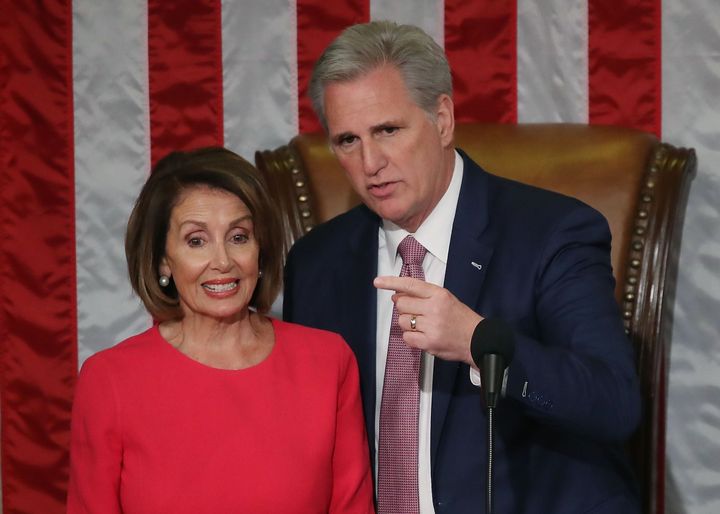House Democrats will start the next Congress with their number diminished, losing at least eight and perhaps 10 seats in the 2020 election. A net loss of eight seats would represent over 3% of current Democratic House members, far from Democrats’ hopes of expanding their headcount by around 12-15 seats.
As of Wednesday afternoon, House Democrats had claimed none of the Democratic Congressional Campaign Committee’s (DCCC) 38 “red-to-blue” district targets to flip from Republicans—for example, striking out on all of the seven pickup targets in Texas, two of which were thought to be leaning Democratic by The Cook Political Report. While Democrats will keep control of the U.S. House and gained two seats in North Carolina through favorable redistricting, it looks like 2020’s losses will reduce their share of the lower chamber to about 51.5% of the total 435 representatives.
Of this cycle’s 42 “frontline” House districts held by vulnerable incumbents according to the DCCC, six losses so far came in districts picked up by Democrats in the 2018 midterms: Reps. Xochitl Torres Small (N.M.), Kendra Horn (Okla.), Joe Cunningham (S.C.), Abby Finkenauer (Iowa), Max Rose (N.Y.), and Debbie Mucarsel-Powell (Fla.). Freshman Democratic Rep. TJ Cox of California narrowly trails David Valadao, who is running to take back his former seat, as votes continue to be counted. In Iowa’s Second Congressional District, composed of the area around Davenport and Iowa City, the race to succeed retiring seven-term Rep. Dave Loebsack, a Democrat, is neck-and-neck.
In Florida, first-term representative Donna Shalala lost by just over 9,400 votes, close to three percent of the vote, in a rematch for the prominent Democrat with Cuban American journalist María Elvira Salazar. In Minnesota, 15-term Rep. Collin Peterson—the chair of the Agriculture Committee and a past favorite of Koch Industry’s PAC donations among Democrats—went down with only 40% of the vote to his opponent’s 53% in a rural district that hugely favored President Trump in 2016.
Endangered Democratic freshmen Reps. Lizzie Fletcher (Tex.), Lucy McBath (Ga.), and New Jersey’s Tom Malinowski and Andy Kim held their seats, and DCCC Chair Cheri Bustos of Illinois declared victory with close to 52% of the vote. Also holding on from 2018 were “frontline” Reps. Mikie Sherill (N.J.), Jason Crow (Col.), and Sharice Davids (Kan.), as well as Dean Phillips (Minn.).
Outspent by McCarthy’s Super PAC
The defeated House Democrats didn’t lack for campaign money, largely bringing in millions of dollars for their reelections and outraising their opponents. Rep. Torres Small raised over $7.5 million, according to the Center for Responsive Politics, compared to $2.5 million raised by her successful Republican challenger Yvette Herrell, and spent nearly 2.7 times as much on the race.
But a super PAC aligned with Minority Leader Kevin McCarthy and the House GOP, the Congressional Leadership Fund (CLF), announced its largest-ever fundraising quarter shortly before the election, bringing in $77.4 million, double its 2018 haul. CLF’s historic third quarter went towards its over $106.7 million in total spending this cycle, as tracked by the Center for Responsive Politics as of Nov. 4.
The top group contributing to CLF this cycle was a conservative “dark money” behemoth: American Action Network (AAN), an affiliated “social welfare” organization that does not disclose its donors. A Sludge review of FEC information shows that AAN gave a record of at least $26.4 million to CLF, more than the $23.5 million it funneled to CLF in the 2018 cycle, which was itself a huge increase over the less than half a million dollars it gave to CLF in 2014 and 2016. Current AAN President Dan Conston also serves as president of CLF, in what the group’s website describes as his second stint. Republican strategist Corry Bliss served as executive director of AAN and CLF in the 2018 midterms, earning a compensation of close to $400,000 according to AAN’s Form 990 for the year ending June 2018. In 2015, Mike Shields, a former top staffer at the National Republican Congressional Committee and Republican National Committee, held the position of president at AAN and CLF.
Other top CLF donors include wealthy Republican megadonor Timothy Mellon, majority owner of transportation holding company Pan Am Systems and also a top contributor to the pro-Trump super PAC America First Action, who gave $10 million last year and another $10 million on June 9 of this year. Republican megadonors Sheldon and Miriam Adelson contributed $40 million combined in the third quarter to CLF, joined by $10 million this cycle from Ken Griffin, founder and CEO of investment firm Citadel. Koch Industries, major fossil fuel companies such as Valero and Chevron, and Republican megadonors Ron Cameron, Elizabeth Uihlein, and members of the DeVos family each made at least six-figure contributions to CLF.
In several elections where Democratic seats got flipped by Republicans, CLF was the top outside spending group, in some cases outspending the candidates’ campaigns. In Torres Small’s race, CLF spent over $4.74 million; in Horn’s, it spent over $4.75 million; in Cunningham’s, almost $4.3 million; and in Finkenauer’s, over $3.7 million. In Rose’s reelection race, CLF spent over $5.4 million, second to the Democratic-aligned House Majority PAC, with over $7.7 million. In Muscarel-Powell’s Florida race, CLF spent close to $4.2 million, second only to the National Republican Congressional Committee’s PAC, with over $4.8 million.
The election results prompted speculation that Speaker Nancy Pelosi, who had been planning to run for Speaker again unopposed, might face a renewed leadership challenge next year, and made it likelier that a new DCCC head would replace Bustos. After the Democrats’ 2018 midterm wave, Pelosi secured her current stint as Speaker, facing a potential leadership challenge, in part by pledging to step aside by 2022.



